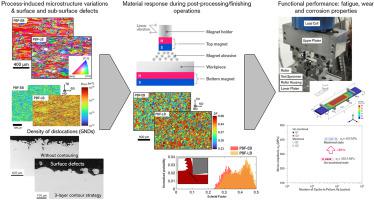International Journal of Machine Tools and Manufacture ( IF 14.0 ) Pub Date : 2022-06-21 , DOI: 10.1016/j.ijmachtools.2022.103908 Amir Malakizadi , Dinesh Mallipeddi , Sasan Dadbakhsh , Rachid M'Saoubi , Peter Krajnik

|
Additive manufacturing (AM) is characterised by several unique advantages, such as (freedom of) design, capability of fusing dissimilar materials, near-net-shape, and achieving a more sustainable production. While the increased precision of metal AM in recent years reduced the needed amount of post-processing to meet dimensional tolerance, the requirements for functional surfaces necessitate a well-understood post-processing, ranging from heat treatment to machining and finishing. The inherently rough initial (as-built) surface topography next to complex material microstructure affects the capability of post-processing/finishing operations to smooth the surface texture and obtain a favourable surface integrity. In this respect, a more fundamental understanding of the effects of material properties on post-processing/finishing is needed. Therefore, this review paper aims to establish the relationship between the characteristics of different AM technologies, microstructural properties of materials in as-built and heat-treated conditions, and the physical properties influencing the response of additively manufactured materials during post-processing/finishing operations. In particular, emphasis is placed on the physics-based understanding of how the microstructural characteristics of 316L, Ti6Al4V and Alloy 718 produced using the two principal technologies, Powder Bed Fusion (PBF) and Direct Energy Deposition (DED), influence their mechanical properties like tensile strengths, hardness and ductility. These properties are among the key factors influencing the response of material during post-processing/finishing operations involving material removal by shear deformation. This review paper also discusses the role of post-processing/finishing on fatigue performance, tribological behaviour and corrosion resistance of investigated AM materials. The paper summarises the state-of the art of post-processing/finishing operations and future research trends are highlighted.
中文翻译:

增材制造金属合金的后处理——综述
增材制造 (AM) 具有几个独特的优势,例如(自由)设计、融合不同材料的能力、近净成型以及实现更可持续的生产。虽然近年来金属增材制造精度的提高减少了满足尺寸公差所需的后处理量,但对功能表面的要求需要从热处理到机加工和精加工的充分理解的后处理。紧挨着复杂材料微观结构的固有粗糙的初始(竣工)表面形貌会影响后处理/精加工操作以平滑表面纹理并获得良好的表面完整性的能力。在这方面,需要更基本地了解材料特性对后处理/精加工的影响。所以,本综述旨在建立不同增材制造技术的特性、竣工和热处理条件下材料的微观结构特性以及在后处理/精加工操作中影响增材制造材料响应的物理特性之间的关系。特别是,重点放在基于物理的理解上,了解使用粉末床融合 (PBF) 和直接能量沉积 (DED) 这两种主要技术生产的 316L、Ti6Al4V 和合金 718 的微观结构特征如何影响它们的机械性能,例如抗拉强度、硬度和延展性。这些特性是影响后处理/精加工操作期间材料响应的关键因素之一,包括通过剪切变形去除材料。本综述还讨论了后处理/精加工对所研究的 AM 材料的疲劳性能、摩擦学行为和耐腐蚀性的作用。本文总结了后处理/精加工操作的最新技术,并强调了未来的研究趋势。











































 京公网安备 11010802027423号
京公网安备 11010802027423号